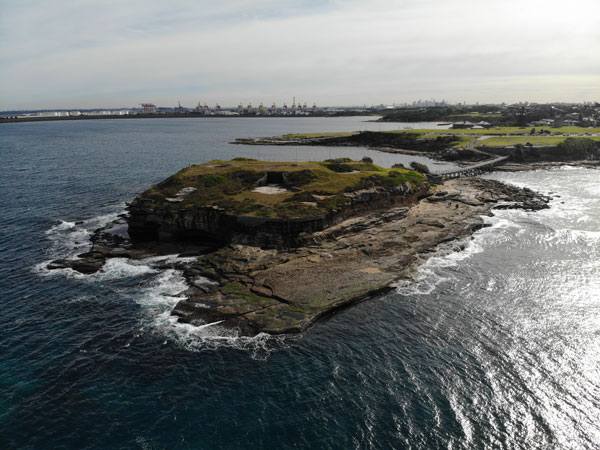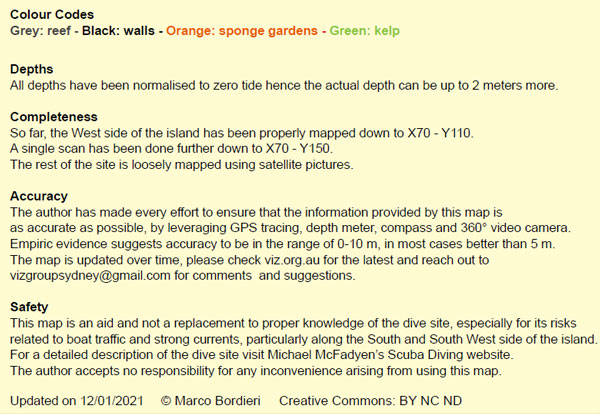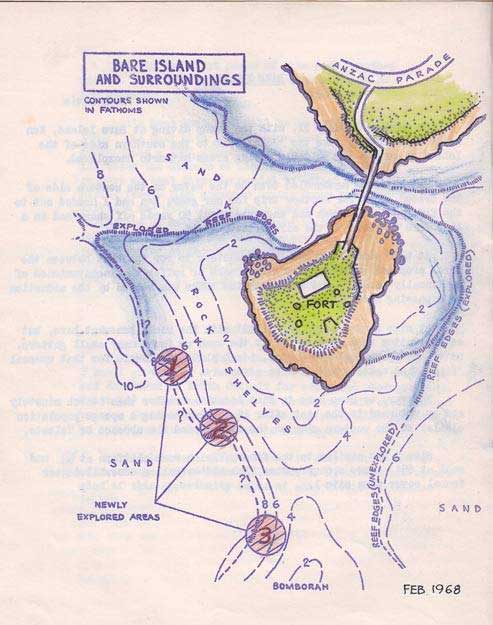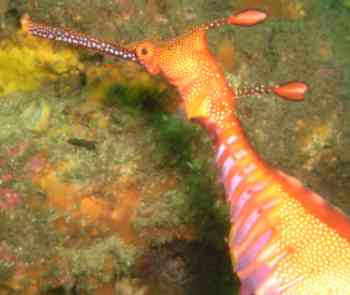|
Michael McFadyen's Scuba Diving - Bare Island Left
Bare Island is perfect for either day or night diving in almost all weather. In even moderate seas you can safely dive in virtually any spot and in very heavy seas you can usually dive the protected western side of the island. A number of different dives can be done around the island itself, as well as along the shore on either side of the bridge.
 |  |
A photograph of Bare Island Left on a perfect day
The mainland entry point is where the divers are and the exit point is to the left of the divers | A drone photograph of Bare Island South East
The entry point is one the closest point |
In this article I will describe two of the better and more popular dives that you can do at Bare Island. Located 20 kilometres from the centre of Sydney, Bare Island is part of Botany Bay National Park. From the city, travel along Anzac Parade or Bunnerong Road to La Perouse and park on the edge of Anzac Parade above the island. I have attached a more detailed map of the left side of Bare Island below.
Both dives are a variation on the one dive, but different enough to mention separately.
BASIC DIVE
 |  |
A new underwater map of Bare Island created by Marco Bordieri from www.viz.net.au.
For a much larger pdf version of this map, click here.
Used with permission of Marco Bordieri | Information about the map at left and below |
The first dive is a very leisurely one and begins on the mainland. Gear up and walk the short distance down the bridge access road to the rock platform on the left of the bridge (but do not cross the bridge). A number of excellent entry and exit points can be found here and it is a matter of entering the water and snorkelling out towards the closest point of the island's rock platform. Half way across, drop to the sandy bottom and locate the edge of the rock shelf. The depth here will be six metres or so. Follow the edge slowly to the east and south-east (keeping the reef on your right) and the depth will gradually increase to eight metres. There will be some rocks and kelp on the sand to your left for the first section and then as you turn more to the south-east, just sand and one or two very small isolated rocks. A lot of small overhangs are on the right and these used to contain crayfish but it is 15 years or so since I saw any at all.
 |  |
| A satellite photograph of Bare Island Left showing the reef | Map of Bare Island
Click to enlarge |
After a short distance you will come across what looks like a small canyon in the rocks but this is in fact the area between the outside main edge of the reef and some larger off-lying rocks. The reef and the rocks are covered with sponges and giant jelly ascidians and they support large numbers of nudibranches, half-banded seaperches and other small fish. Head down the canyon to the south. In July 2005 there was a sea dragon living here. It has no tail, just a stub. As you go, explore the many minor overhangs and holes that can be found along the island's edge. The depth will increase to 9 or 10 metres. You will start to see sea dragons on the sand from about here.
 |
A larger version of the section of underwater map of Bare Island as above, created by Marco Bordieri from www.viz.net.au.
For a much larger pdf version of this map, click here.
Used with permission of Marco Bordieri |
Thirty metres along the canyon you will see a large cave on your right. This is a very interesting cave and is worth a close examination. You cannot enter the cave as it is not high enough. It is often home to wobbegongs and during late winter and early spring I have seen up to 35 Port Jackson sharks located in this cave and the one a few metres further south. The very distinctive knightfish (pineapplefish) is sometimes found in the first cave. I have seen one individual in the cave for a period of three or four months at a time.
 |  |
A map produced in 1968 by URG Underwater Research Group).
May have been drawn by Clarrie Lawler (see right) | A diagram/map of Bare Island East done by Clarrie Lawler in the early 1960s.
Used with permission of Denise Lawler |
Just before the cave, you will see a small crack running off at 45 degrees to your right. This goes up and over the rock wall and eventually returns back to the wall above the cave. It is an interesting diversion.
Past the cave a low shelf runs out away from the main wall. On here there are many sponges and if you look carefully on the rocks in this area you may also see tiny nudibranches of many different species. Just near here, on the sand about five metres off the cave, I first saw a tiny 75 mm long sea dragon in December 2000. This means that the sea dragon was aboout 1.5 months old. The same sea dragon was still there in March 2001, but of course a bit bigger (about 150 to 175 mm) but it seemed to disappear some time after this. See the link at the end of the next paragraph for more information on sea dragons and sizes/age.
In the section of reef past this point, we have been finding pygmy pipe horses since early 2006. In January 2007 we found six here, five red ones and one white one. They ranged in size from 10 mm to 40 mm. It appears to me that December to February is the best time to see them.
If you are examining the terrain quite close, it will have taken you about 20 minutes to get here. The wall turns back towards the island and you will reach a flatter area. The seascape will have changed from a rock reef wall to a bottom made up of a flat kelp covered rock and sand to your left with less marine and fishlife around. Keep following the sand edge until the edge turns to the south-east, then south and then south-west before again turning south. In December 2000 I saw a large (orange) red Indianfish on the sand near here. In July 2005 I saw another (or the same one?) but a bit further out. Along this section of the dive you will see many sea dragons. I never saw a single sea dragon on this side of the island till about 1995 but in the period 1995 to 2001 you were certain to see many.
 |  |
| A very small pygmy pipe horse | An even smaller pygmy pipe horse,
with my finger as a scale |
On a dive here in late 2000 (done as described here) here I saw eight in this area, but in March 2001 I saw a total of 25 from the bridge to the bombora (about 100 metres further on). However, on Christmas Day 2001 I only saw one sea dragon, a pregnant male and on 27 January 2002 I only saw one. I have no idea why the numbers appeared to drop so dramatically. However, in July 2005 I saw 12 on one dive. This is a first, showing that sea dragons may move long distances. For more information about sea dragons, see my Sea Dragon Page.
If you want to turn around here, you can head straight across the rocks in a north-westerly direction for a couple of minutes and you will reach the wall again. You will now be off the far end of Bare Island where the wall is much smaller and less defined. Follow the wall back towards the north-east and north until you begin to track back over your outward route. Return back along the same route. Maximum depth is about 12 metres. You can continue on if you have sufficient air or follow the sand edge back instead of the wall.
On this dive you will see bearded cod, estuary catfish, beardie, bream, cuttlefish, old wife, mado, stripey, red and blue morwong, maori wrasse, crimson-banded wrasse, mosaic leatherjacket, six-spined leatherjacket, silver sweep, smooth flutemouth, blackspot goatfish, white ear, blue groper, mullet, sergeant baker, yellow-eyed leatherjacket, knightfish, snapper, crayfish, abalone, octopus, prawns, shrimp, herring cale, crab, senator wrasse, Port Jackson shark, yellowtail, silver drummer, moray eel and neon damsel. You may also see huge bullrays.
This dive is also an excellent night dive, at times one of the best Sydney has to offer. Do exactly the same dive as described above though you will probably not get as far to the south. There is always a myriad of fishlife to be seen including most of those list in the previous paragraph. You will have a better chance of seeing lined dumpling squid, squid, crab, and crayfish.
ISLAND START
 |
| A close up of a common sea dragon at Bare Island |
The second dive here starts from the back left corner of the island. After walking across the bridge and down the new set of steps (built not as a result of lobbying by Sydney Dive Academy as they claim but because I and my then most regular dive buddy Eddy, convinced our regular squash partner, a fellow officer of the National Parks and Wildlife Service and the Manager of the area that they were needed) at the end, go out to the back of the island. In calm seas there is a good entry point closest to the open sea. After entering the water, swim a few metres off the wall and start the dive.
This is actually the best way to do the dive as you do not cover as much of the same section of reef twice.
First go to the south-east until you hit the sand edge. If you are good on your air consumption, head south till you have used about 25% of your air. Then turn around and follow the sand edge back to the north. As you go, examine the sponges on the rocks and also the sand (for sea dragons). Eventually you will come to the area where the cave is located.
<>
By doing the first dive in reverse to the way it was described earlier, you will end up back on the mainland near the bridge. As mentioned, there are a number of different places to exit the water, depending on the tides. Pick the most suitable before entering the water.
Average visibility here is of the order of six to nine metres, you do not need much more. However, I have been lucky to have 15 metres about 20 times and 25 metres three times in the more than 80 dives here.
Sea dragons at Bare Island Left
| DATE | NUMBER | COMMENTS |
| 30-Nov-1995 | 2 | |
| 14-Apr-1996 | 3 | |
| 26-Jul-1997 | 2 | |
| 8-May-1999 | 2 | 1 juvenile |
| 10-Dec-2000 | 8 | 3 males with eggs |
| 29-Dec-2000 | 2 | 1 male with eggs
1 75mm long juvenile |
| 7-Jan-2001 | 13 | 75mm one from last dive |
| 14-Mar-2001 | 25 | |
| 17-May-2001 | 1 | juvenile from 29-Dec but now bigger |
| 27-May-2001 | 4 | |
| 25-Dec-2001 | 1 | 1 males with eggs |
| 27-Jan-2002 | 1 | |
| 23-Jun-2002 | 1 | |
| 21-Aug-2002 | 0 | |
| 4-Jan-2004 | 3 | |
| 3-Dec-2004 | 1 | juvenie |
| 3-Mar-2005 | 2 | |
| 1-Apr-2005 | 0 | |
| 7-Jul-2005 | 12 | no tail near start gutter |
| 22-Sep-2005 | 4 | 1 with eggs |
| 18-May-2006 | 0 | |
| 4-Sep-2006 | 3 | |
| 14-Dec-2006 | 3 | |
| 17-Dec-2006 | 2 | |
| 7-Jan-2007 | 0 | |
| 19-Dec-2007 | 0 | |
| 3-May-2008 | 0 | |
| 17-Jan-2013 | 0 | |
| 1-Jun-2013 | 0 | |
| 9-Jan-2014 | 0 | |
| 15-Apr-2018 | 1 | |
| 
 v6.00.307 © 2003-2005
v6.00.307 © 2003-2005